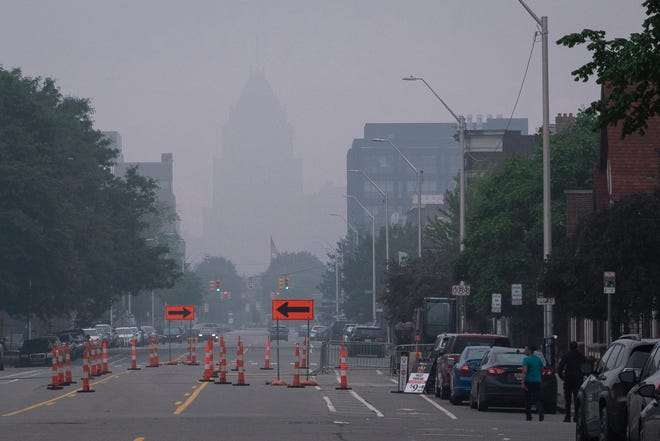In early June 2023, smoke from massive wildfires in Quebec, Canada, fell on the northeastern United States, immediately causing lung-related health issues.
Researchers looking at data from emergency departments at 53 New York City hospitals found that asthma-related emergency room visits increased by nearly 44% during the smoky days, peaking on June 7, when the city’s air quality was at its worst due to smoke from Canada.
Dr. Lawrence MacDonald, chief of pulmonology at DMC Huron Valley Sinai Hospital in Commerce Township, Michigan, a suburb of Detroit, said his hospital also saw an increase in patients with lung problems in its emergency room last summer, when smoke from Canadian wildfires blanketed the region for days.
“We’ve seen a noticeable increase in asthma exacerbations, need for steroids, increased treatments, and trips to the emergency room,” he said. “When this substance is in the air, it increases your chances of getting sick, developing symptoms, and going to the emergency room.”
According to the World Health Organization, wildfire smoke can contain a mix of harmful air pollutants, including fine particulate matter (PM2.5), nitrogen dioxide, ozone, aromatic hydrocarbons, and lead. In addition to polluting the air with toxic pollutants, wildfires also simultaneously affect the climate by releasing large amounts of carbon dioxide and other greenhouse gases into the atmosphere.
Wildfire smoke can be deadly: Here’s why
Perhaps the most insidious pollutant is PM2.5, particles smaller than 2.5 microns—about 30 times smaller than the thickness of a human hair. According to MacDonald, the body’s defense systems—moist tissues containing immune cells in the nose and throat and mucus in the airways of the lungs—are designed to trap particles and expel them when we cough or sneeze. But PM2.5 is so small that it can slip past these defenses and find its way deep into the lungs and their tiny air sacs.
“Our lungs are designed to protect us from these things, but very small particles can evade and escape our body’s built-in defense systems,” he said.
Children, the elderly, pregnant women and people with underlying conditions such as asthma and COPD are most susceptible to health complications from wildfire smoke. The WHO notes that PM2.5 from wildfire smoke has been linked to premature death and can cause or aggravate diseases of the lungs, heart, brain, nervous system, skin, intestines, kidneys, eyes, nose and liver. It has also been shown to lead to cognitive impairment and memory loss.
What should you do? Stay home.
A new study from the Yale School of Public Health looked at the relationship between long-term exposure to PM2.5 from wildfire smoke across the continental United States between 2007 and 2020 and fatalities. The study, which excluded PM2.5 exposure from other types of air pollution and other potential sources, found that when a region’s wildfire smoke PM2.5 concentrations were 5 micrograms per cubic meter or higher as a 12-month rolling average, the number of non-accidental deaths per month increased by just over 2 per 100,000 people exposed. Mortality was also found to increase slightly when average air concentrations were between 0.1 and 5 micrograms per cubic meter per month.
“Certainly throughout the Midwest and East, we’re going to see some of the worst air pollution on record from wildfire smoke in 2023,” said Vijay LeMay, a Wisconsin-based environmental epidemiologist and director of applied research initiatives at the nonprofit environmental group Natural Resources Defense Council.
“From a public health perspective, this is really worrying. We can see smoggy air, but these tiny particles are dangerous to us, even at much lower levels than what we’ve experienced.”
more:80-year-old Smokey Bear headlines National Cherry Festival amid controversy over icon’s message
more:‘We were unprepared’: Canada battles nightmare wildfires as smoke becomes U.S. problem
When wildfire smoke falls on an area, there’s not much people can do other than avoid it. The U.S. Environmental Protection Agency recommends staying indoors with doors and windows closed and running air conditioners with high-efficiency filters if possible. The use of portable air purifiers is also recommended.
The EPA recommends that people without such facilities should consider finding another place to escape the smoke if possible. They should also avoid adding to indoor air pollution by lighting candles, using gas, propane or wood stoves or fireplaces, vacuuming or using aerosol sprays.
MacDonald said people with asthma or other heart or lung conditions should work closely with their doctors to develop an enhanced response plan if wildfire smoke increases breathing difficulties.
“We’re going to have a lot of people coming in who don’t have a doctor or who have a doctor but don’t have a plan,” he said.
“If someone ends up in the emergency department, that’s a failure of care.”
Contact Keith Matheny at kmatheny@freepress.com. This story was produced with support from the Pulitzer Center.


